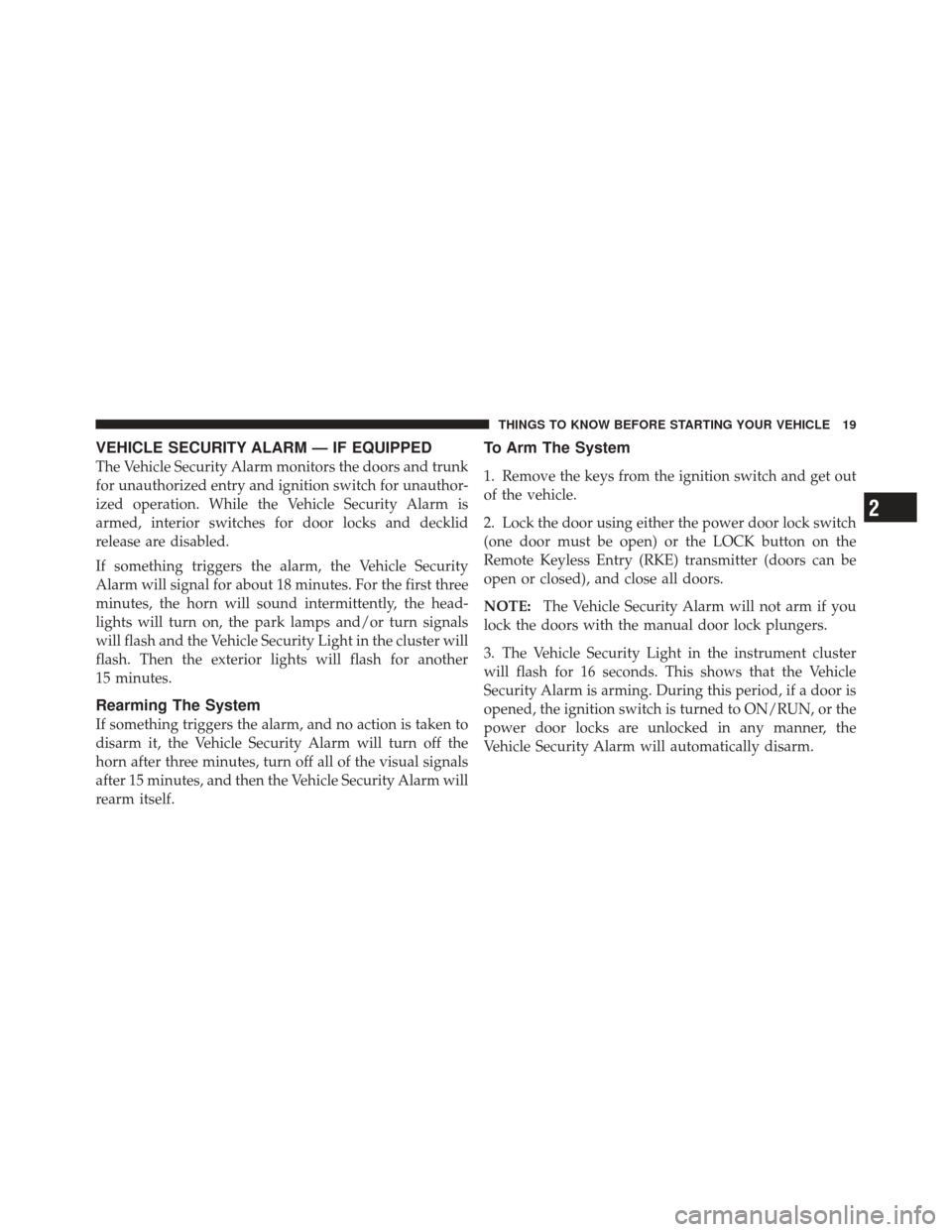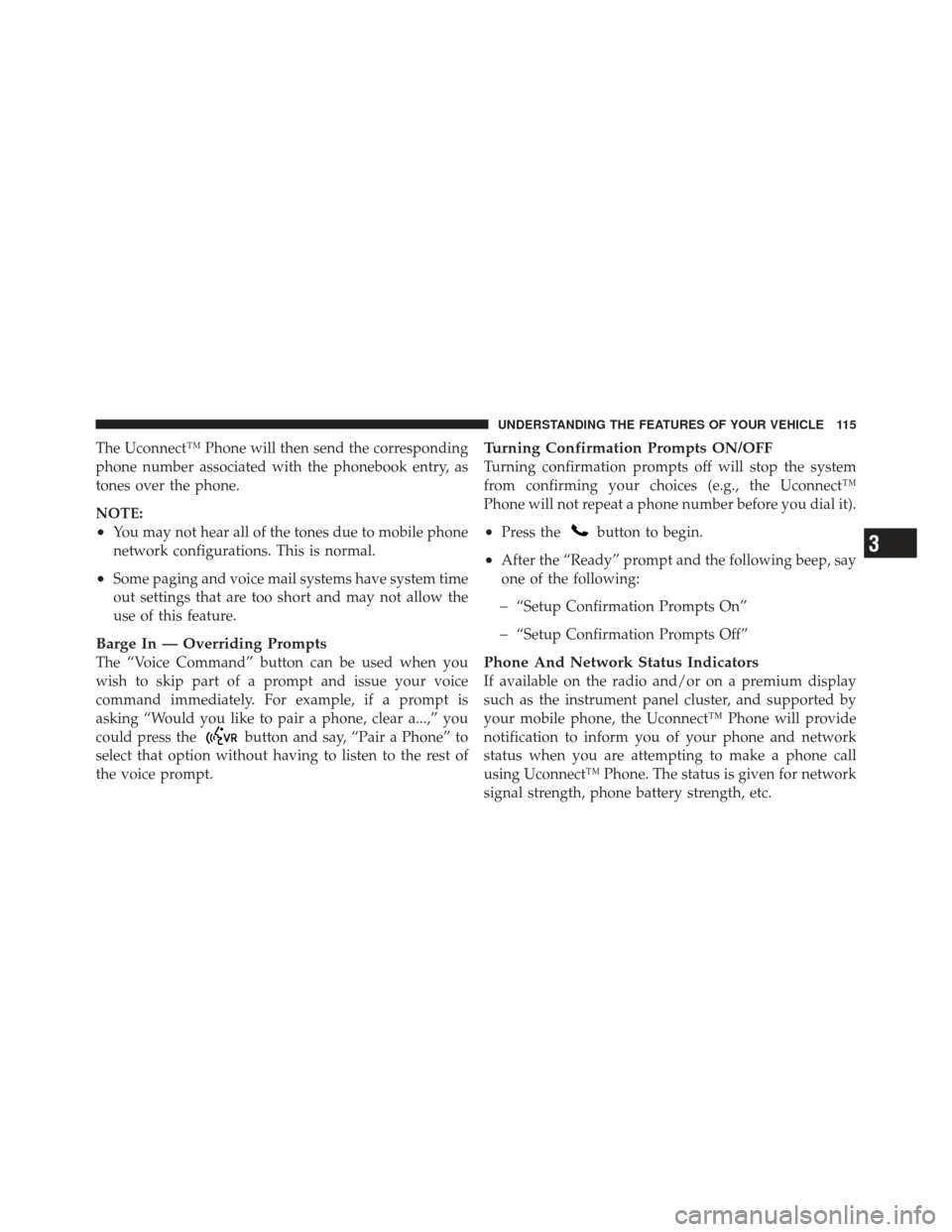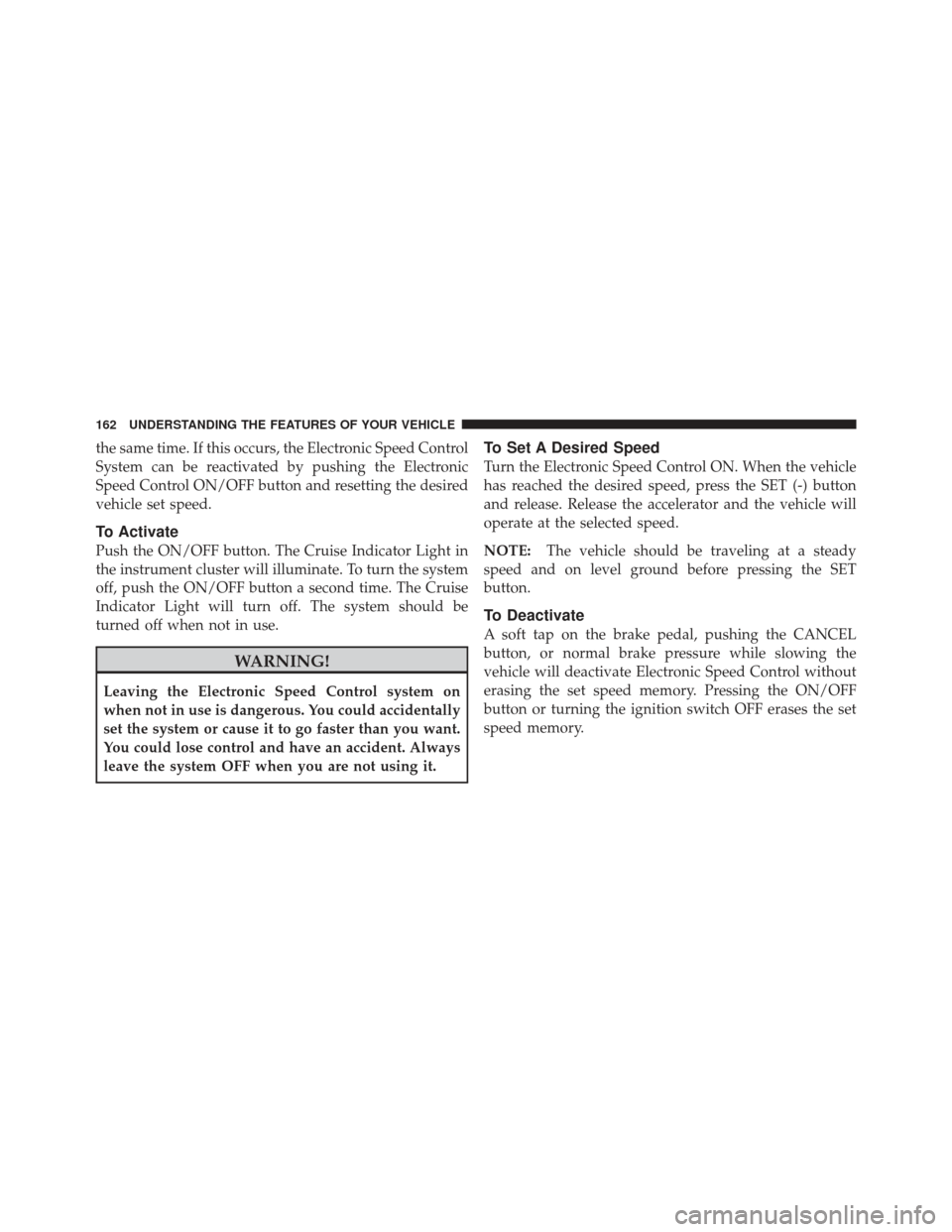Page 21 of 514

VEHICLE SECURITY ALARM — IF EQUIPPED
The Vehicle Security Alarm monitors the doors and trunk
for unauthorized entry and ignition switch for unauthor-
ized operation. While the Vehicle Security Alarm is
armed, interior switches for door locks and decklid
release are disabled.
If something triggers the alarm, the Vehicle Security
Alarm will signal for about 18 minutes. For the first three
minutes, the horn will sound intermittently, the head-
lights will turn on, the park lamps and/or turn signals
will flash and the Vehicle Security Light in the cluster will
flash. Then the exterior lights will flash for another
15 minutes.
Rearming The System
If something triggers the alarm, and no action is taken to
disarm it, the Vehicle Security Alarm will turn off the
horn after three minutes, turn off all of the visual signals
after 15 minutes, and then the Vehicle Security Alarm will
rearm itself.
To Arm The System
1. Remove the keys from the ignition switch and get out
of the vehicle.
2. Lock the door using either the power door lock switch
(one door must be open) or the LOCK button on the
Remote Keyless Entry (RKE) transmitter (doors can be
open or closed), and close all doors.
NOTE:The Vehicle Security Alarm will not arm if you
lock the doors with the manual door lock plungers.
3. The Vehicle Security Light in the instrument cluster
will flash for 16 seconds. This shows that the Vehicle
Security Alarm is arming. During this period, if a door is
opened, the ignition switch is turned to ON/RUN, or the
power door locks are unlocked in any manner, the
Vehicle Security Alarm will automatically disarm.
2
THINGS TO KNOW BEFORE STARTING YOUR VEHICLE 19
Page 67 of 514

Because air bag sensors measure vehicle deceleration
over time, vehicle speed and damage by themselves are
not good indicators of whether or not an air bag should
have deployed.
Seat belts are necessary for your protection in all colli-
sions, and also are needed to help keep you in position,
away from an inflating air bag.
The ORC monitors the readiness of the electronic parts of
the air bag system whenever the ignition switch is in the
START or ON/RUN position. If the key is in the OFF
position, in the ACC position, or not in the ignition, the
air bag system is not on and the air bags will not inflate.
The ORC contains a backup power supply system that
may deploy the air bags even if the battery loses power or
it becomes disconnected prior to deployment.Also, the ORC turns on the Air Bag Warning
Light in the instrument panel for approxi-
mately four to eight seconds for a self-check
when the ignition is first turned on. After the
self-check, the Air Bag Warning Light will turn off. If the
ORC detects a malfunction in any part of the system, it
turns on the Air Bag Warning Light, either momentarily
or continuously. A single chime will sound if the light
comes on again after initial startup.
It also includes diagnostics that will illuminate the instru-
ment cluster Air Bag Warning Light if a malfunction is
noted that could affect the air bag system. The diagnos-
tics also record the nature of the malfunction.
2
THINGS TO KNOW BEFORE STARTING YOUR VEHICLE 65
Page 117 of 514

The Uconnect™ Phone will then send the corresponding
phone number associated with the phonebook entry, as
tones over the phone.
NOTE:
•You may not hear all of the tones due to mobile phone
network configurations. This is normal.
•Some paging and voice mail systems have system time
out settings that are too short and may not allow the
use of this feature.
Barge In — Overriding Prompts
The “Voice Command” button can be used when you
wish to skip part of a prompt and issue your voice
command immediately. For example, if a prompt is
asking “Would you like to pair a phone, clear a...,” you
could press the
button and say, “Pair a Phone” to
select that option without having to listen to the rest of
the voice prompt.
Turning Confirmation Prompts ON/OFF
Turning confirmation prompts off will stop the system
from confirming your choices (e.g., the Uconnect™
Phone will not repeat a phone number before you dial it).
•Press thebutton to begin.
•After the “Ready” prompt and the following beep, say
one of the following:
�“Setup Confirmation Prompts On”
�“Setup Confirmation Prompts Off”
Phone And Network Status Indicators
If available on the radio and/or on a premium display
such as the instrument panel cluster, and supported by
your mobile phone, the Uconnect™ Phone will provide
notification to inform you of your phone and network
status when you are attempting to make a phone call
using Uconnect™ Phone. The status is given for network
signal strength, phone battery strength, etc.
3
UNDERSTANDING THE FEATURES OF YOUR VEHICLE 115
Page 154 of 514
Turn Signals
Move the multifunction lever up or down and the arrows
on each side of the instrument cluster flash to show
proper operation of the front and rear turn signal lights.NOTE:
If either light remains on and does not flash, or
there is a very fast flash rate, check for a defective outside
light bulb. If an indicator fails to light when the lever is
moved, it would suggest that the indicator bulb is
defective.
Lane Change Assist
Tap the lever up or down once, without moving beyond
the detent, and the turn signal (right or left) will flash
three times then automatically turn off.
High/Low Beam Switch
Push the multifunction lever away from you to switch
the headlights to high beam. Pull the lever toward you, to
switch the headlights back to low beam.
Turn Signal Control
152 UNDERSTANDING THE FEATURES OF YOUR VEHICLE
Page 164 of 514

the same time. If this occurs, the Electronic Speed Control
System can be reactivated by pushing the Electronic
Speed Control ON/OFF button and resetting the desired
vehicle set speed.
To Activate
Push the ON/OFF button. The Cruise Indicator Light in
the instrument cluster will illuminate. To turn the system
off, push the ON/OFF button a second time. The Cruise
Indicator Light will turn off. The system should be
turned off when not in use.
WARNING!
Leaving the Electronic Speed Control system on
when not in use is dangerous. You could accidentally
set the system or cause it to go faster than you want.
You could lose control and have an accident. Always
leave the system OFF when you are not using it.
To Set A Desired Speed
Turn the Electronic Speed Control ON. When the vehicle
has reached the desired speed, press the SET (-) button
and release. Release the accelerator and the vehicle will
operate at the selected speed.
NOTE:The vehicle should be traveling at a steady
speed and on level ground before pressing the SET
button.
To Deactivate
A soft tap on the brake pedal, pushing the CANCEL
button, or normal brake pressure while slowing the
vehicle will deactivate Electronic Speed Control without
erasing the set speed memory. Pressing the ON/OFF
button or turning the ignition switch OFF erases the set
speed memory.
162 UNDERSTANDING THE FEATURES OF YOUR VEHICLE
Page 191 of 514
UNDERSTANDING YOUR INSTRUMENT PANEL
CONTENTS
�Instrument Panel Features ............... 193
� Instrument Cluster .................... 194
� Instrument Cluster — R/T ............... 195
� Instrument Cluster Descriptions ........... 196
� Mini-Trip Computer — If Equipped ........ 210
▫ Control Buttons ..................... 210
� Electronic Vehicle Information Center (EVIC) —
If Equipped .......................... 211
▫ Electronic Vehicle Information Center (EVIC)
Displays ........................... 213 ▫
Oil Change Required — If Equipped ...... 215
▫ EVIC Main Menu .................... 215
▫ Compass Display .................... 216
▫ Average Fuel Economy ................ 219
▫ Distance To Empty (DTE) .............. 219
▫ TirePSI ........................... 220
▫ Elapsed Time ....................... 220
▫ EVIC Units Selection (Units In Display) .... 220
▫ System Status ....................... 221
4
Page 195 of 514
INSTRUMENT PANEL FEATURES
1 — Air Outlet5 — Passenger Airbag9 — Power Outlet
2 — Side Window Demister Outlet 6 — Glove Compartment 10 — Climate Controls
3 — Instrument Cluster 7 — Heated Seat Switch — If Equipped 11 — Ignition Switch
4 — Radio 8 — Hazard Switch12 — Trunk Release Button
4
UNDERSTANDING YOUR INSTRUMENT PANEL 193
Page 196 of 514
INSTRUMENT CLUSTER
194 UNDERSTANDING YOUR INSTRUMENT PANEL